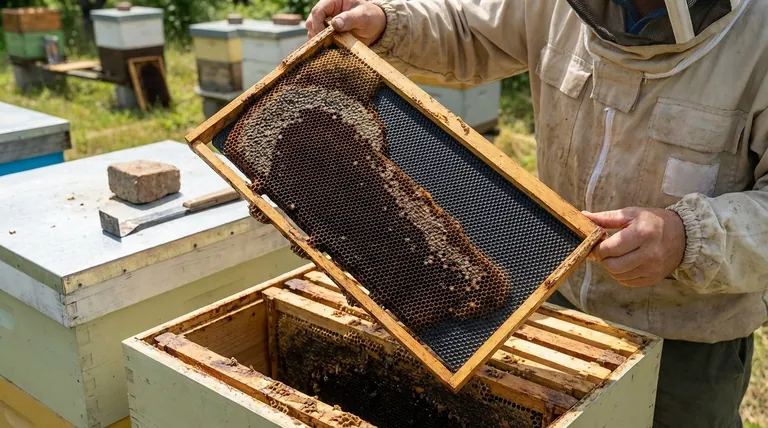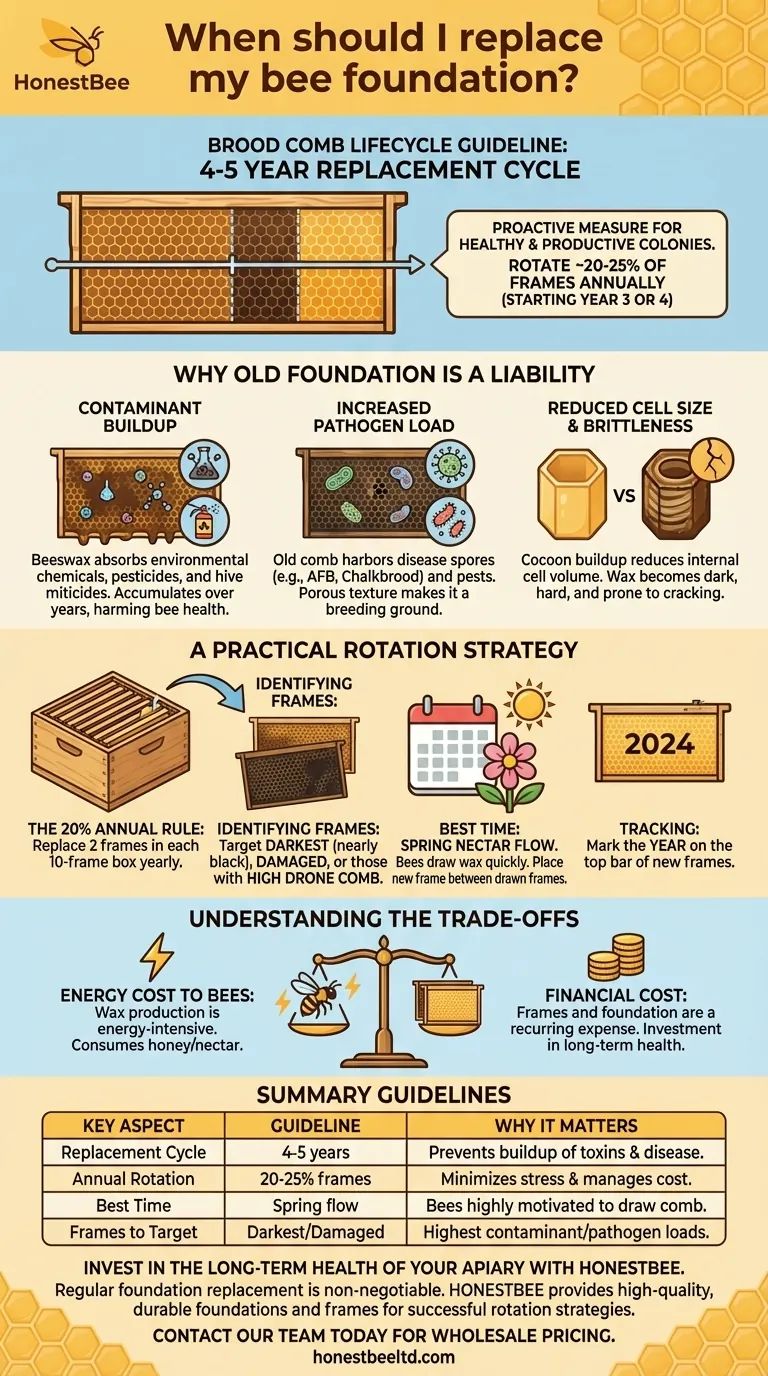Knowing when to replace your bee foundation is a critical, proactive measure for maintaining a healthy and productive colony. As a general guideline, the brood comb foundation should be on a 4-5 year replacement cycle. This is typically achieved by rotating out about 20-25% of the frames in your brood boxes each year, starting around year three or four.
The core issue isn't the age of the wax itself, but what it absorbs over time. Beeswax acts like a sponge for environmental chemicals and pathogens, and regular replacement is the most effective way to detoxify the hive and break disease cycles.

Why Old Foundation Becomes a Liability
Foundation that has been used for several seasons, especially in the brood chamber, poses several risks to the colony. Over time, it transitions from a clean nursery to a potential source of contamination and stress.
The Problem of Contaminant Buildup
Beeswax is lipid-based, meaning it readily absorbs fat-soluble chemicals. This includes agricultural pesticides the bees may encounter while foraging and, just as importantly, the chemical treatments (miticides) used inside the hive to control Varroa mites. Over years, these residues can accumulate to levels that harm bee health.
Increased Pathogen Load
Old, dark comb is a perfect environment for pests and diseases. The porous texture of old cocoons and propolis can harbor the spores of serious diseases like American Foulbrood (AFB) and Chalkbrood. Regularly removing this old comb is a fundamental part of hive sanitation.
Reduced Cell Size and Brittleness
With each generation of brood that hatches, a thin cocoon is left behind in the cell. Over many years, this buildup can slightly reduce the internal volume of the cell. Furthermore, old wax becomes dark, hard, and very brittle, making it prone to cracking or breaking during hive inspections.
A Practical Rotation Strategy
Instead of replacing all your frames at once, which would be a massive setback for the colony, a gradual rotation is the industry standard. This minimizes stress and resource cost for the bees.
The 20% Annual Rule
The most common and manageable method is to replace two frames in each 10-frame brood box every year. This establishes a simple 5-year cycle, ensuring no comb gets too old.
How to Identify Frames for Rotation
Each spring, assess the frames in your brood chamber. The ones you want to remove are typically the darkest, nearly black combs. You can also target frames that are damaged, have a high percentage of drone comb, or contain old, crystalized honey.
The Best Time and Place for New Foundation
The ideal time to add new frames with fresh foundation is during a strong nectar flow in the spring. The bees will be motivated to produce wax and draw out the new comb quickly. For best results, place the new frame between two fully drawn brood frames to encourage the bees to work on it immediately.
A Simple Tracking System
Keeping track of frame age is crucial. A simple method is to use a permanent marker to write the year on the top bar of each new frame you add. This takes the guesswork out of identifying your oldest frames in subsequent seasons.
Understanding the Trade-offs
While foundation rotation is highly beneficial, it's important to understand the associated costs. This allows you to make informed decisions that are right for your specific operation.
The Energy Cost to Bees
Producing beeswax is incredibly energy-intensive. Bees must consume large quantities of honey or nectar to fuel their wax glands. Forcing a colony to draw out too much new foundation at once can significantly slow its growth and honey production. This is why a gradual rotation is superior to a complete overhaul.
The Financial Cost to the Beekeeper
Frames and foundation represent a recurring expense. For beekeepers with many hives, this cost can be significant. However, it should be viewed as a necessary investment in the long-term health and productivity of your colonies.
Making the Right Choice for Your Hive
Your rotation strategy should align with your primary goals as a beekeeper.
- If your primary focus is maximum hive health and disease prevention: Adhere to a strict 4-5 year rotation by replacing 20-25% of your brood frames annually.
- If your primary focus is balancing cost with safety: Always target the oldest, darkest, and most damaged combs for removal each year, even if it's only one or two per hive.
- If you have acquired an established hive with old equipment: Begin a more aggressive rotation, replacing 30-40% of the frames in the first year to quickly improve the hive's internal environment.
Proactively managing your foundation is one of the most effective investments you can make in the long-term resilience of your bees.
Summary Table:
| Key Aspect | Guideline | Why It Matters |
|---|---|---|
| Replacement Cycle | 4-5 years for brood comb | Prevents buildup of pesticides, miticides, and disease spores. |
| Annual Rotation | Replace 20-25% of brood frames yearly | Minimizes stress on bees and manages costs effectively. |
| Best Time to Replace | During a strong spring nectar flow | Bees are most motivated to draw out new comb quickly. |
| Frames to Target | Darkest, nearly black, or damaged combs | These hold the highest contaminant and pathogen loads. |
Invest in the long-term health of your apiary with HONESTBEE.
Regular foundation replacement is non-negotiable for modern, productive beekeeping. As a trusted wholesale supplier for commercial apiaries and equipment distributors, HONESTBEE provides the high-quality, durable foundations and frames you need to implement a successful rotation strategy.
Let us help you build a healthier, more resilient operation. Contact our team today to discuss your supply needs and wholesale pricing.
Visual Guide

Related Products
- Food Grade Plastic bee Foundation for Bee Frames
- Beeswax Foundation Sheets Beehive Foundation for Wholesale
- Manual Beeswax Comb Foundation Machine Wax Foundation Mill Embossing Machine
- Colorful Silicone Beeswax Foundation Mold Mould for Beekeeping
- Professional Frame Preparation: The HONESTBEE Electric Wire Embedder
People Also Ask
- How to get bees to draw out plastic foundation? Boost Comb Building with Proven Tactics
- What is a plastic foundation sheet? A Durable, Reusable Hive Management Solution
- How does plastic foundation differ from beeswax foundation? Choose the Best for Your Hive's Success
- Why is it beneficial to coat plastic foundation with beeswax? Boost Hive Acceptance & Comb Building
- How do you get bees to draw out plastic foundation? Master the Art of Comb Building



















